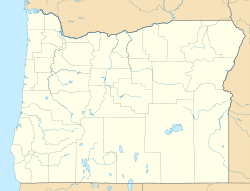Draft:Battle Rock
Battle Rock | |
|---|---|
Promontory | |
 Battle Rock, looking South | |
Location of Battle Rock in Oregon | |
| Coordinates: 42°44′21″N 124°29′18″W / 42.7392756°N 124.4884377°W[1] | |
| Location | Curry county, Oregon, U.S. |
| Offshore water bodies | Pacific Ocean |
| Age | Jurassic, Mesozoic |
| Geology | Composed of basalt |
| Topo map | USGS Port Orford |
Battle Rock, or Battle Rock Arch, is a promontory on the west coast of the United States of America. It is located in the deep Southwest of Oregon, near the small coastal city of Port Orford. The rock is composed mainly of basalt, and is part of the coastal Otter Point Formation. In 1851, a small skirmish broke out on the rock between white settlers and the indigenous Quatomah Tututnis, the Athapaskan people who lived in the area. The settlers eventually fled, before returning in greater numbers and establishing a fort at Cape Orford. The skirmish passed into local legend, becoming a part of Port Orford's community celebrations and folklore.
Local Geography
[edit]Battle Rock lies within the boundaries of Port Orford; the city's borders are drawn specifically around it.[2] The formation is constrained to the south by the Pacific Ocean and to the north by both a beach named for the rock and by the townsite of Orford itself.[1] At approximately 124 degrees, 29 minutes, and 18 seconds west longitude, Battle Rock is one of the westernmost places in Oregon, ceding first to the nearby Port Orford Heads, and then to Cape Blanco.[citation needed] The surrounding land is mostly covered in coniferous forest, a few geographical points (such as nearby Mount Humbug) shaping a landscape of mountains, valleys, and low hills.[3]
Climate
[edit]The region around Battle Rock has an oceanic climate (Csb according to the Köppen climate classification system) with cool, very wet winters and mild, dry summers.[4] The average annual precipitation is 72.61 in (1,844 mm).[5] It is at the northern end of Oregon's "banana belt", a region with relatively warm weather caused by the Brookings effect. Its hardiness zone is 9b.[6]
| Climate data for Port Orford, Oregon | |||||||||||||
|---|---|---|---|---|---|---|---|---|---|---|---|---|---|
| Month | Jan | Feb | Mar | Apr | May | Jun | Jul | Aug | Sep | Oct | Nov | Dec | Year |
| Record high °F (°C) | 79 (26) |
78 (26) |
78 (26) |
84 (29) |
91 (33) |
88 (31) |
97 (36) |
96 (36) |
93 (34) |
89 (32) |
77 (25) |
80 (27) |
97 (36) |
| Mean daily maximum °F (°C) | 54.4 (12.4) |
55.0 (12.8) |
55.4 (13.0) |
56.9 (13.8) |
60.7 (15.9) |
63.9 (17.7) |
67.5 (19.7) |
68.2 (20.1) |
67.2 (19.6) |
63.1 (17.3) |
57.3 (14.1) |
54.5 (12.5) |
60.3 (15.7) |
| Mean daily minimum °F (°C) | 41.6 (5.3) |
41.2 (5.1) |
42.3 (5.7) |
44.1 (6.7) |
47.7 (8.7) |
50.9 (10.5) |
53.9 (12.2) |
53.7 (12.1) |
51.3 (10.7) |
47.6 (8.7) |
43.5 (6.4) |
40.7 (4.8) |
46.5 (8.1) |
| Record low °F (°C) | 21 (−6) |
19 (−7) |
27 (−3) |
28 (−2) |
28 (−2) |
35 (2) |
39 (4) |
35 (2) |
36 (2) |
28 (−2) |
24 (−4) |
13 (−11) |
13 (−11) |
| Average precipitation inches (mm) | 11.60 (295) |
8.51 (216) |
9.34 (237) |
6.79 (172) |
3.39 (86) |
1.90 (48) |
0.40 (10) |
0.56 (14) |
1.54 (39) |
4.82 (122) |
10.16 (258) |
12.62 (321) |
71.63 (1,818) |
| Average snowfall inches (cm) | 0 (0) |
0.1 (0.25) |
0 (0) |
0 (0) |
0 (0) |
0 (0) |
0 (0) |
0 (0) |
0 (0) |
0 (0) |
0 (0) |
0.1 (0.25) |
0.2 (0.51) |
| Average precipitation days (≥ 0.05 in) | 18.5 | 16.5 | 17 | 14 | 10 | 7 | 3 | 4 | 5 | 10.3 | 18 | 19 | 142.3 |
| Source: NOAA[7] | |||||||||||||
Geology
[edit]
Battle Rock is composed mainly of basalt.[8] It lies almost detached from the mainland, and though its exact elevation and dimensions are unknown, sources indicate a length from north to south of roughly 100 yards (91 m) and an elevation of roughly 60 feet (18 m).[9][10] It is part of the Otter Point Formation, a belt-like geological formation that extends a ways along the coast.[8] Geologists estimate that most of the land in the Otter Point Formation can be dated back to the Jurassic period, while relatively nearby Humbug Mountain is made of lower cretaceous bedrock.[8]
History
[edit]
References
[edit]- ^ a b "Battle Rock Topo Map in Curry County OR". topozone.com. TopoZone. Retrieved March 31, 2025.
- ^ "Port Orford Map Plans" (PDF). shojiplanning.com. ShojiPlanning. Retrieved March 30, 2025.
- ^ Snoke, Arthur; Barnes, Calvin (January 1, 2006). Geological Studies in the Klamath Mountains Province, California and Oregon. Geological Society of America. p. 156. Retrieved May 15, 2025.
- ^ "Port Orford, Oregon Köppen Climate Classification (Weatherbase)". Weatherbase.com. Retrieved December 16, 2017.
- ^ "PORT ORFORD 2, OREGON - Climate Summary". Wrcc.dri.edu. Retrieved December 16, 2017.
- ^ "Zip Code 97465 Profile, Map and Demographics - December 2017". Archived from the original on December 17, 2017. Retrieved December 16, 2017.
- ^ "NOAA NCEI U.S. Climate Normals Quick Access". National Oceanic and Atmospheric Administration. Retrieved January 8, 2022.
- ^ a b c Lund, Ernest (April 1975). "COASTAL LANDFORMS CURRY COUNTY" (PDF). The Ore Bin. 37: 58, 76. Retrieved March 31, 2025.
- ^ Fitzhugh, Adam. Battle Rock: Anatomy of a Massacre (PDF). Retrieved March 31, 2025.
- ^ Bancroft, Hubert (1888). History of Oregon. The History Company. pp. 195–204. Retrieved March 31, 2025.


